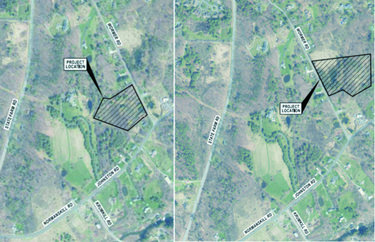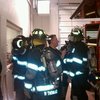More battery storage proposed for New Scotland
NEW SCOTLAND — A trio of large-scale battery energy storage systems were recently submitted to the New Scotland Planning Board for its review and approval.
New Leaf Energy’s applications identify the properties as 37 and 128 Wormer Road owned by New Scotland Councilman Adam Greenberg.
New Leaf’s proposal marks the second, third, and fourth energy-storage system proposed in town; RIC Energy is looking to install a system on Indian Fields Road in Feura Bush.
With the zoning board having to weigh in on the project’s needed variance and the planning board's continued review of the proposal, Chairman Jeffrey Baker said a public hearing remains at least two months away.
The 13.8-acre parcel at 37 Wormer Road would house one battery energy storage system, or BESS, facility, while 128 Wormer Road, a 13-acre site parcel, would have two BESS, and would require a variance, as town code says each storage system must be located on a seven-acre site.
Each project application notes the sites are “currently vacant and mainly forested with sparse open areas.”
New Leaf is proposing a five-megawatt and 20,000-kilowatt-hour system at 37 Wormer Road and two similar systems at 128 Wormer. The proposed project would involve the installation of a total of 15 Tesla-made units that stockpile renewable energy collected during the day and send it to the grid during peak-use evening hours. Each unit measures eight feet high by six feet wide and is 30 feet long.
A kilowatt-hour is a unit of measurement that signifies the amount of energy required to keep a device consuming one kilowatt, or 1,000 watts, running for one hour.
The kilowatt-hour differs from the kilowatt in that a kilowatt is a measurement of consumption; it indicates the amount of power a device needs just to kick on while the kilowatt-hour measures the total energy used over a period of time.
Each battery system is designed to discharge 20,000 kilowatt-hours — roughly equivalent to the average daily electricity consumption of almost 700 homes — over a four-hour period.
Safety concerns
National data shows serious BESS failures are rare, but do pose a risk to firefighters, especially volunteer departments that may lack training and resources to deal with the unique hazards.
In New Scotland, RIC has a four-hour training session scheduled for Sept. 13 at the Onesquethaw Volunteer Fire Company’s Tarrytown Road station.
As with RIC, chief among the planning board’s concerns with New Leaf’s proposal on Sept. 2 were fire safety and the readiness of volunteer first-responders.
Unlike almost all fires, BESS emergency response plans typically advise a defensive “let it burn” approach, where first-responders apply massive volumes of water to the exterior of adjacent, uninvolved battery units to prevent the fire from spreading, while the initial unit burns itself out. The primary strategy is not extinguishing but cooling.
Representatives from New Leaf told New Scotland Planning board members that the company had reached out to the New Salem fire chief, but it was noted that a multi-agency coordination was necessary as 128 Warner Road borders two other fire districts, Westmere and Guilderland Center.
When the availability of sufficient water supply for fire suppression was raised, the board was pointed to an existing on-site pond whose viability as a dry hydrant had yet to be determined.
Board member Dan Byrnes wanted to know about the BESS monitoring and shutdown protocols.
Byrnes asked if communication infrastructure such as broadband or cell towers were to fail, would the local safety system still be able to function autonomously to shut down the battery and prevent a hazardous event.
Byrnes was told that, while the system is indeed monitored remotely, the battery unit itself possesses the local intelligence to detect a problem and initiate a shutdown sequence “without any external communication.”
Greenberg’s view
Greenberg told The Enterprise on Sept. 5 that he initially received letters about property he owns next to a substation in East Greenbush.
“They were looking into that, and I mentioned that I had some other property if they were interested,” he said; New Leaf Energy became interested in the New Scotland sites after checking on access to the nearby substation.
“I would say on the New Scotland properties, maybe a year ago we started to talk about that or they started to look into it,” he said.
Asked about the appearance of impropriety, Greenberg said, “I was approached after that law was passed,” referencing the town’s adoption of an energy storage law in April 2024.
Greenberg went on, “I don’t think that law is an outlier law from other towns.” He added that he didn’t have a hand in writing the law, only that he voted to approve the resolution.
Councilman Dan Leinung spearheaded the town’s adoption of its energy storage law.
Later in the interview, Greenberg noted that, while he is a member of the town board, he’s also a resident. “I have properties. I also have to go through the proper channels,” he said.
The project is subject to special-use permit and site-plan review, but the planning board’s review is essentially treated as one process, Town Planner Rebecca Platel explained by email.
Greenberg said the BESS “are relatively small, hidden things. They’re not going to be seen really from the road.” In comparison to solar farms, which have visual issues associated with them, a BESS “can be hidden pretty well,” he said.
Speaking to the safety of battery energy storage systems, Greenberg noted there’s “been a large [safety] focus around these sites … And there should be; that definitely should be looked at.”
He went on, “We should certainly be concerned with those things, but we also have to weigh that against the benefit to the community and our power grid.”
Greenberg concluded, “I think we all know that our power grid needs to be updated, and we need to incorporate as much positive technology into it as we can to make the grid work for our communities in the most efficient way. [BESS] are certainly part of the future to do that, and that is why the state is pushing hard for these.”


